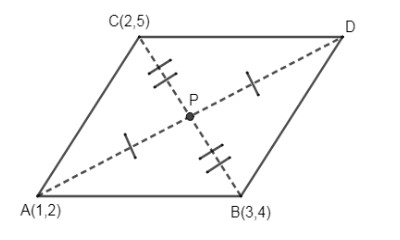
If in a parallelogram ABCD, the coordinates of A, B and C are respectively (1, 2), (3, 4) and (2, 5) then the equation of the diagonal AD is
Answer
592.5k+ views
Hint:Draw parallelogram ABCD and mark the given points. The diagonals of the parallelogram intersect equal. Thus the point of intersection becomes the mid – point of diagram. Find mid – point using mid – point formula then use two point formula to find equation of diagonal AD.
Complete step-by-step answer:
We have been given a parallelogram ABCD. Along with this we know the coordinates of points A, B and C which are respectively A (1, 2), B (3, 4) and C (2, 5). Now let us draw a parallelogram plotting all these values.

Let AD and BC be the diagonals of the parallelogram. We know that the diagonals of a parallelogram intersect equally. Thus let us mark the point where diagonals AD and BC intersect as P. From the figure you can say that P is the mid – point of the diagonal BC and AD.
Now, by using mid – point theorem, you can get the value of P. As P is the mid – point of BC, we can get the value of P, using the formula,
Mid – point of BC \[=\left( \dfrac{{{x}_{1}}+{{x}_{2}}}{2},\dfrac{{{y}_{1}}+{{y}_{2}}}{2} \right)\]
Take \[\left( {{x}_{1}},{{y}_{1}} \right)=C\left( 2,5 \right)\] and \[\left( {{x}_{2}},{{y}_{2}} \right)=B\left( 3,4 \right)\].
\[\therefore \] P = Mid – point of BC = \[\left( \dfrac{2+3}{2},\dfrac{5+4}{2} \right)=\left( \dfrac{5}{2},\dfrac{9}{2} \right)\]
Thus we got the coordinates of P as \[\left( \dfrac{5}{2},\dfrac{9}{2} \right)\].
Now, we need to find the equation of line AD.
We know the value of 2 points A (1, 2) and P \[\left( \dfrac{5}{2},\dfrac{9}{2} \right)\].
Thus let us use the formula for finding equation of line as,
\[\dfrac{y-{{y}_{1}}}{{{y}_{2}}-{{y}_{1}}}=\dfrac{x-{{x}_{1}}}{{{x}_{2}}-{{x}_{1}}}\]
Put \[\left( {{x}_{1}},{{y}_{1}} \right)=\left( 1,2 \right)\] and \[\left( {{x}_{2}},{{y}_{2}} \right)=\left( \dfrac{5}{2},\dfrac{9}{2} \right)\].
We can rearrange the above formula as,
\[y-{{y}_{1}}=\left( \dfrac{{{y}_{2}}-{{y}_{1}}}{{{x}_{2}}-{{x}_{1}}} \right)\left( x-{{x}_{1}} \right)\]
Now let us substitute the value of \[\left( {{x}_{1}},{{y}_{1}} \right)\] and \[\left( {{x}_{2}},{{y}_{2}} \right)\].
\[\left( y-2 \right)=\left( \dfrac{\dfrac{9}{2}-2}{\dfrac{5}{2}-1} \right)\left( x-1 \right)\Rightarrow \left( y-2 \right)=\dfrac{5}{3}\left( x-1 \right)\]
Let us cross multiply and simplify it.
\[\begin{align}
& 3\left( y-2 \right)=5\left( x-1 \right) \\
& \Rightarrow 3y-6=5x-5 \\
& \Rightarrow 5x-3y-5+6=0 \\
& 5x-3y+1=0 \\
\end{align}\]
Thus we got the equation of diagonal as \[5x-3y+1=0\].
Note: In the two point formula, \[m=\dfrac{{{y}_{2}}-{{y}_{1}}}{{{x}_{2}}-{{x}_{1}}}\], which represent the equation formula of slope. The formula can be written as, \[\left( y-{{y}_{1}} \right)=m\left( x-{{x}_{1}} \right)\]. Thus you can find slope and substitute or use the formula directly.
Complete step-by-step answer:
We have been given a parallelogram ABCD. Along with this we know the coordinates of points A, B and C which are respectively A (1, 2), B (3, 4) and C (2, 5). Now let us draw a parallelogram plotting all these values.

Let AD and BC be the diagonals of the parallelogram. We know that the diagonals of a parallelogram intersect equally. Thus let us mark the point where diagonals AD and BC intersect as P. From the figure you can say that P is the mid – point of the diagonal BC and AD.
Now, by using mid – point theorem, you can get the value of P. As P is the mid – point of BC, we can get the value of P, using the formula,
Mid – point of BC \[=\left( \dfrac{{{x}_{1}}+{{x}_{2}}}{2},\dfrac{{{y}_{1}}+{{y}_{2}}}{2} \right)\]
Take \[\left( {{x}_{1}},{{y}_{1}} \right)=C\left( 2,5 \right)\] and \[\left( {{x}_{2}},{{y}_{2}} \right)=B\left( 3,4 \right)\].
\[\therefore \] P = Mid – point of BC = \[\left( \dfrac{2+3}{2},\dfrac{5+4}{2} \right)=\left( \dfrac{5}{2},\dfrac{9}{2} \right)\]
Thus we got the coordinates of P as \[\left( \dfrac{5}{2},\dfrac{9}{2} \right)\].
Now, we need to find the equation of line AD.
We know the value of 2 points A (1, 2) and P \[\left( \dfrac{5}{2},\dfrac{9}{2} \right)\].
Thus let us use the formula for finding equation of line as,
\[\dfrac{y-{{y}_{1}}}{{{y}_{2}}-{{y}_{1}}}=\dfrac{x-{{x}_{1}}}{{{x}_{2}}-{{x}_{1}}}\]
Put \[\left( {{x}_{1}},{{y}_{1}} \right)=\left( 1,2 \right)\] and \[\left( {{x}_{2}},{{y}_{2}} \right)=\left( \dfrac{5}{2},\dfrac{9}{2} \right)\].
We can rearrange the above formula as,
\[y-{{y}_{1}}=\left( \dfrac{{{y}_{2}}-{{y}_{1}}}{{{x}_{2}}-{{x}_{1}}} \right)\left( x-{{x}_{1}} \right)\]
Now let us substitute the value of \[\left( {{x}_{1}},{{y}_{1}} \right)\] and \[\left( {{x}_{2}},{{y}_{2}} \right)\].
\[\left( y-2 \right)=\left( \dfrac{\dfrac{9}{2}-2}{\dfrac{5}{2}-1} \right)\left( x-1 \right)\Rightarrow \left( y-2 \right)=\dfrac{5}{3}\left( x-1 \right)\]
Let us cross multiply and simplify it.
\[\begin{align}
& 3\left( y-2 \right)=5\left( x-1 \right) \\
& \Rightarrow 3y-6=5x-5 \\
& \Rightarrow 5x-3y-5+6=0 \\
& 5x-3y+1=0 \\
\end{align}\]
Thus we got the equation of diagonal as \[5x-3y+1=0\].
Note: In the two point formula, \[m=\dfrac{{{y}_{2}}-{{y}_{1}}}{{{x}_{2}}-{{x}_{1}}}\], which represent the equation formula of slope. The formula can be written as, \[\left( y-{{y}_{1}} \right)=m\left( x-{{x}_{1}} \right)\]. Thus you can find slope and substitute or use the formula directly.
Recently Updated Pages
Master Class 11 Business Studies: Engaging Questions & Answers for Success

Master Class 11 Computer Science: Engaging Questions & Answers for Success

Master Class 11 Maths: Engaging Questions & Answers for Success

Master Class 11 Chemistry: Engaging Questions & Answers for Success

Master Class 11 Economics: Engaging Questions & Answers for Success

Master Class 11 Accountancy: Engaging Questions & Answers for Success

Trending doubts
What is meant by exothermic and endothermic reactions class 11 chemistry CBSE

10 examples of friction in our daily life

One Metric ton is equal to kg A 10000 B 1000 C 100 class 11 physics CBSE

1 Quintal is equal to a 110 kg b 10 kg c 100kg d 1000 class 11 physics CBSE

Difference Between Prokaryotic Cells and Eukaryotic Cells

What are Quantum numbers Explain the quantum number class 11 chemistry CBSE




